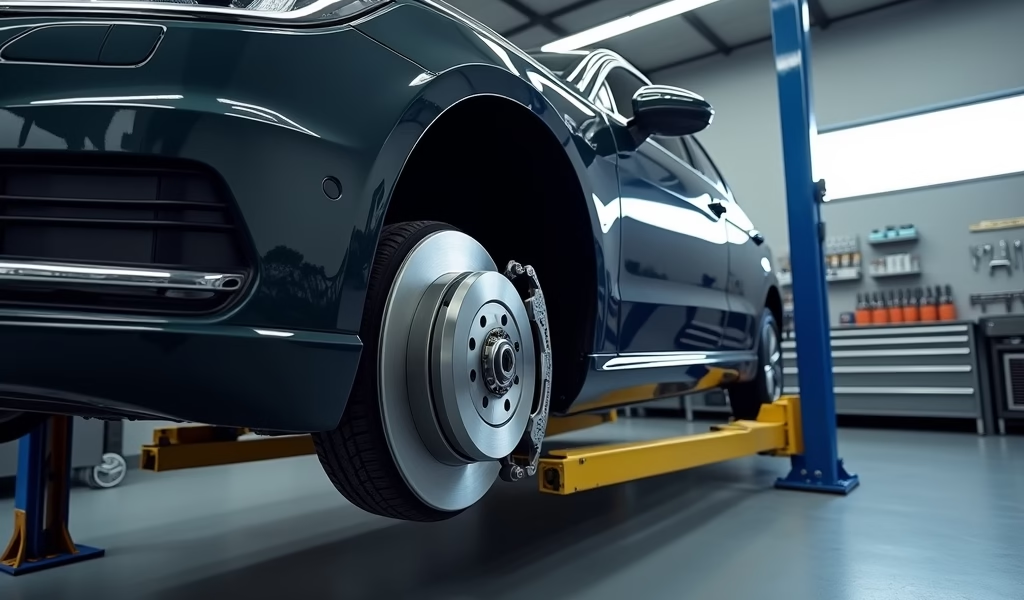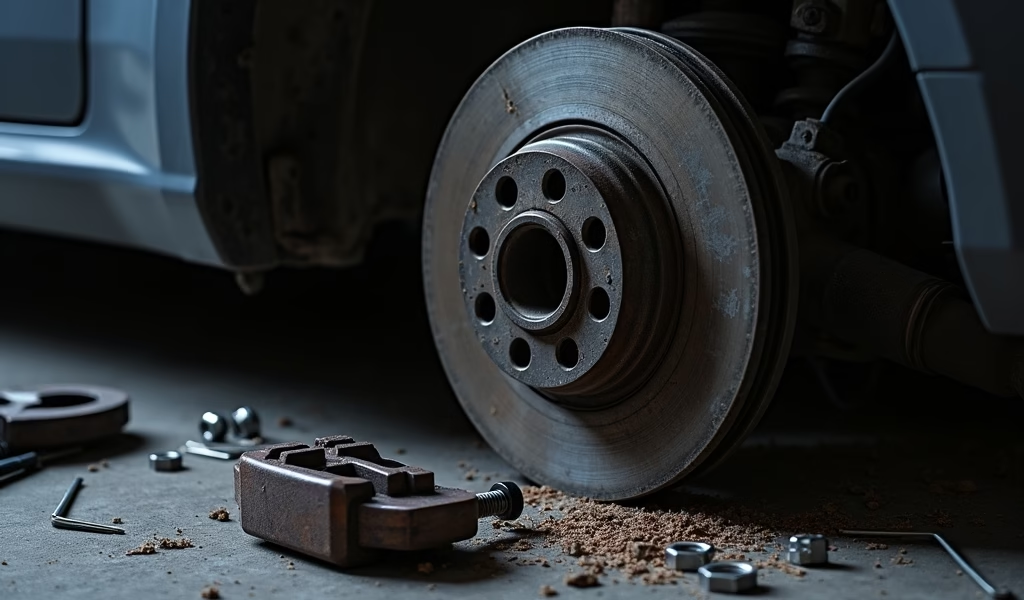Overview
This article provides expert guidance on measuring rotor hat height—a critical but often overlooked aspect of brake system maintenance that affects braking performance and safety. The author presents five pro tips covering proper preparation, measuring techniques, specification tolerances, documentation practices, and replacement decisions, while emphasizing that precise measurement requires specialized tools and attention to detail to prevent issues like uneven brake pad wear and pedal pulsation.
Table of Contents
- Understanding Rotor Hat Height
- The Importance of Accurate Rotor Hat Height Measurement
- Essential Tools for Rotor Hat Height Measurement
- Pro Tip 1: Proper Preparation is Key
- Pro Tip 2: Perfect Your Measuring Technique
- Pro Tip 3: Understanding Specification Tolerances
- Pro Tip 4: Documentation and Tracking
- Pro Tip 5: When to Replace vs. Machine
- Common Mistakes to Avoid
- Conclusion
- Frequently Asked Questions
Understanding Rotor Hat Height
Rotor hat height measurement is a critical yet often overlooked aspect of brake system maintenance. As a professional mechanic with over 15 years in the field, I’ve seen countless vehicles suffer from premature brake wear, vibration, and even safety issues due to improper rotor hat measurements. The rotor hat, sometimes called the mounting bell or mounting flange, is the raised center portion of the brake rotor that attaches to the wheel hub. Its height directly affects how the rotor sits relative to the caliper, which in turn influences braking performance.
When working on a vehicle’s braking system, understanding this measurement is as important as checking disc brake rotor thickness. The hat height determines the lateral runout of the rotor – too much variation and you’ll end up with a brake pedal that pulses or a steering wheel that shakes during braking. Let me walk you through everything you need to know about properly measuring rotor hat height and why it matters for your vehicle’s safety and performance.
The Importance of Accurate Rotor Hat Height Measurement
Getting this measurement right isn’t just about being thorough—it’s about ensuring the entire braking system functions as designed. When rotor hat height is incorrect, several problems can develop:
- Uneven brake pad wear that reduces pad life by up to 40%
- Brake pedal pulsation that can be felt through the steering wheel
- Excessive lateral runout leading to caliper piston knock-back
- Potential for premature bearing failure due to uneven loading
- Increased stopping distances during emergency braking
According to research from the Society of Automotive Engineers, as little as 0.002 inches of variance in rotor hat height can begin to create noticeable effects on braking performance. This might seem insignificant, but in the world of precision brake components, it’s substantial.
Professional shops understand this and follow manufacturer specifications carefully. When you’re measuring rotor hat height, you’re essentially checking whether the mating surface of the rotor is parallel to the brake friction surface, which determines how evenly the brake pads contact the rotor during braking.

Essential Tools for Rotor Hat Height Measurement
Before diving into the measurement process, let’s make sure you have the right tools on hand. Accuracy is impossible without proper equipment, and when it comes to rotor hat height measurement, precision is non-negotiable.
Required Tools:
- Digital or dial indicator with magnetic base
- Precision straight edge (at least 12 inches long)
- Micrometer calibrated to 0.0001 inch precision
- Clean shop towels and brake cleaner
- Feeler gauges for supplementary measurements
- Service manual or online specs for your specific vehicle
The most critical tool is a quality dial indicator. I prefer using a digital model with a magnetic base that can be securely attached to a solid part of the suspension or frame. NIST standards recommend tools calibrated to at least 0.0001-inch precision for brake component measurements, which helps ensure you’re getting readings that are actually useful.
Remember, measuring rotor hat height isn’t something you can eyeball or estimate. Even experienced mechanics rely on precision tools for this task. The investment in quality measuring equipment pays dividends in accurate diagnosis and repair.
Pro Tip 1: Proper Preparation is Key
The first step to accurate rotor hat height measurement happens before you even pick up a measuring tool. Proper preparation of the brake components is essential for meaningful results. In my shop, I’ve developed a preparation routine that helps eliminate variables that could throw off your measurements.
Start by ensuring the vehicle is safely supported on jack stands or a lift. Remove the wheel and thoroughly clean both the rotor and hub mating surfaces. Even the smallest particle of rust or debris can create misleading readings. Use a high-quality brake cleaner and a wire brush to clean the hub surface, paying special attention to any corrosion around the lug studs and centering ring.
For the rotor itself, clean both sides of the hat section, especially the area where it contacts the hub. Any buildup here directly affects your measurements. I like to use fine-grit sandpaper or a light file to carefully remove any raised burrs or rust ridges that might have formed on the mating surfaces. Be gentle—we’re removing contamination, not reshaping the metal.
A final wipe with brake cleaner on a lint-free cloth ensures no residue remains. This preparation may seem excessive, but I’ve seen measurement variations of up to 0.005 inches simply due to surface contamination—more than enough to cause problems.
Pro Tip 2: Perfect Your Measuring Technique
Now that everything’s clean, let’s get to the actual measurement process. The technique you use significantly impacts accuracy. Here’s my step-by-step approach:
- Mount the rotor loosely on the hub using at least three lug nuts hand-tightened in a star pattern
- Set up your dial indicator so the plunger contacts the rotor’s friction surface perpendicular to the face
- Zero the indicator at a reference point on the rotor surface
- Slowly rotate the rotor 360 degrees, noting the highest and lowest readings
- Calculate the total runout (the difference between highest and lowest points)
- Repeat the measurement at multiple radii on the rotor face
The key insight many mechanics miss is that you should take measurements at different distances from the center. Measuring only at one radius doesn’t tell the whole story. I recommend checking at least three positions: near the inner edge, at the middle of the friction surface, and near the outer edge.
Additionally, mark the high spots with a paint pen or chalk. This allows you to determine if the issue is with the rotor itself or with the hub mounting surface. If the high spot rotates with the rotor when you reposition it on the hub, the issue is with the rotor. If it stays in the same place relative to the vehicle, the problem is likely with the hub.

Pro Tip 3: Understanding Specification Tolerances
Knowing what numbers to look for is just as important as knowing how to measure. Manufacturer specifications for rotor hat height and runout vary widely between vehicle makes and models. As a general rule, most passenger vehicles specify maximum lateral runout between 0.002 and 0.005 inches, but always check the specific specs for the vehicle you’re working on.
Some high-performance vehicles have even tighter tolerances, sometimes as little as 0.001 inches of allowable runout. Commercial vehicles might allow slightly more. The Automotive Brake Manual provides standardized specifications that can be helpful when manufacturer data isn’t readily available.
Remember that these are maximum allowable specifications. In practice, I aim for measurements well below the maximum. If a vehicle specifies 0.004 inches maximum runout, I want to see no more than 0.002 inches for a quality repair. This provides a margin of safety as components wear in.
It’s worth noting that rotor hat height itself (the actual dimensional measurement from mounting surface to friction surface) is less commonly specified than lateral runout. When it is specified, typical tolerances are in the range of ±0.001 to ±0.003 inches from nominal. This measurement becomes particularly important when matching new rotors to existing calipers.
Pro Tip 4: Documentation and Tracking
One practice that separates professional technicians from amateurs is documentation. Keeping records of your measurements does more than just cover you legally—it provides valuable insight over time. When I measure rotor hat height and runout, I record the following:
- Date and mileage of measurement
- Specific measurements at inner, middle, and outer radius
- Rotor thickness measurements (to track wear patterns)
- Notes about any abnormal wear patterns observed
- Corrective actions taken (machining, replacement, indexing)
This documentation allows you to track how quickly rotors are developing runout issues, which can point to other problems in the suspension or wheel bearings. It also helps when diagnosing repeat issues—if a vehicle comes back with brake vibration shortly after service, comparing current measurements to previous ones can be illuminating.
I keep a dedicated brake measurement log for each regular customer’s vehicle. This level of detail builds trust and demonstrates professional attention to detail. It also helps me recommend preventive maintenance before problems become severe enough to damage other components.
Pro Tip 5: When to Replace vs. Machine
Once you’ve measured and found that rotor hat height or runout exceeds specifications, you face a decision: should you machine the rotor or replace it? This decision isn’t always straightforward, but I’ve developed some guidelines over the years.
Consider replacement when:
- The rotor is already at or near minimum thickness specification
- The runout exceeds 0.008 inches (generally difficult to correct by machining)
- There’s visible heat damage (blue discoloration or cracks)
- The vehicle has a history of repeated runout issues
- The cost difference between machining and replacement is minimal
Machining may be appropriate when:
- The rotor has ample remaining thickness above minimum spec
- Runout is moderate (0.003-0.007 inches) and consistent
- No heat damage or cracking is present
- You have access to a precision brake lathe with runout compensation
Modern vehicles with lighter-weight rotors often benefit more from replacement than machining. These thinner rotors have less “meat” to work with and are more prone to warping after being machined. Plus, with the competitive pricing of many aftermarket rotors, the economics increasingly favor replacement.
When machining, always check the final runout after installation. I’ve seen freshly machined rotors still exhibit excessive runout when mounted, usually due to hub issues that weren’t addressed. Remember, the goal is correct brake operation, not just passing a single measurement.
Common Mistakes to Avoid
Over my years in the shop, I’ve seen mechanics repeatedly make the same errors when measuring rotor hat height. Avoiding these common pitfalls will save you time and ensure accurate results:
Not Measuring Installed Runout
Many technicians measure rotors on the brake lathe but fail to check them once installed on the vehicle. The interaction between the hub and rotor mounting surfaces is crucial and can only be assessed when the rotor is mounted on the actual vehicle.
Using Worn or Uncalibrated Tools
Dial indicators and micrometers are precision instruments that require regular calibration. Using a worn or dropped indicator can give false readings that lead to unnecessary parts replacement or missed problems.
Ignoring Hub Condition
Sometimes the problem isn’t the rotor at all, but the hub it mounts to. Hub face runout can transfer directly to the rotor. Always check the hub surface with your dial indicator before blaming the rotor.
Improper Torque Sequence
When mounting the rotor for measurement, the torque pattern matters. Always tighten lug nuts in a star pattern to even pressure distribution. Uneven tightening can temporarily distort the rotor, giving false readings.
Measuring Only One Spot
As mentioned earlier, taking measurements at just one radius on the rotor face doesn’t give you the complete picture. Multiple measurements at different distances from the center provide more comprehensive data.
By avoiding these common mistakes, you’ll get more accurate measurements and make better repair decisions. This translates directly to better brake performance and fewer comebacks.
Conclusion
Mastering rotor hat height measurement is one of those skills that separates exceptional mechanics from average ones. It requires attention to detail, proper tools, and a methodical approach. By following the five pro tips outlined in this article—proper preparation, perfecting your measuring technique, understanding specifications, documenting your work, and making informed replace-or-machine decisions—you’ll deliver brake repairs that are safer, more durable, and free from the common issues that plague less careful work.
Remember that brake work isn’t just about replacing parts—it’s about ensuring a critical safety system functions precisely as designed. Accurate rotor hat height measurement is a fundamental part of that process. Whether you’re a professional mechanic or a dedicated DIYer, taking the time to measure correctly pays dividends in vehicle safety, performance, and customer satisfaction.
The next time you’re faced with a brake job, put these techniques into practice. Your customers (or your own vehicle) will benefit from smoother braking, longer component life, and the peace of mind that comes from knowing the job was done right. And isn’t that what quality automotive repair is all about?
Frequently Asked Questions
What exactly is rotor hat height?
Rotor hat height refers to the dimensional measurement from the rotor’s mounting surface to its friction surface. It determines how the rotor sits relative to the caliper, affecting brake pad contact and overall braking performance.
How often should rotor hat height be measured?
Measure rotor hat height whenever you’re servicing brakes or investigating brake-related vibrations. Regular measurement should be part of every brake pad replacement service.
Can I measure rotor hat height without special tools?
No, proper measurement requires a dial indicator or digital gauge with a magnetic base. Attempting to measure without proper tools will give inaccurate results that can compromise brake safety.
What causes rotor hat height to change over time?
Heat cycling, uneven cooling, and mechanical stress during braking can all cause subtle changes in rotor dimensions. Corrosion between the rotor and hub can also affect the mounted height.
Is rotor hat height the same as lateral runout?
No, they’re related but different measurements. Hat height is a dimensional measurement, while lateral runout measures how much the rotor’s friction surface varies as it rotates.

